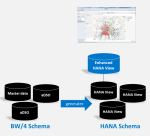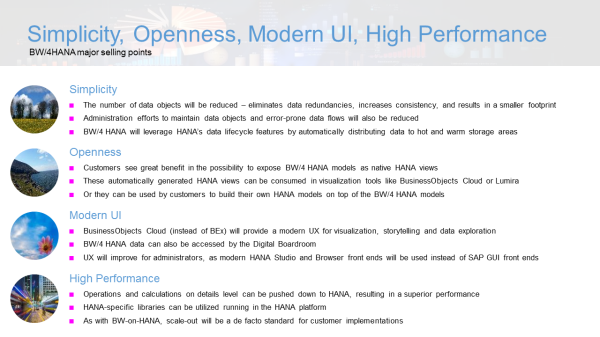
- SAP Community
- Products and Technology
- Technology
- Technology Blogs by SAP
- What is #BW4HANA?
- Subscribe to RSS Feed
- Mark as New
- Mark as Read
- Bookmark
- Subscribe
- Printer Friendly Page
- Report Inappropriate Content
 BW/4HANA is an evolution of BW that is completely optimised and tailored to HANA. The BW/4HANA code can only run on HANA as it is interwoven with HANA engines and libraries. The ABAP part is several million lines of code smaller compared to BW-on-HANA. It is free of any burden to stay, e.g., within a certain, "common denominator scope" of SQL, like SQL92 or OpenSQL, but can go for any optimal combination with what the HANA platform offers. The latter is especially important as it extends into the world of big data via HANA VORA, an asset that will be heavily used by BW/4HANA.
BW/4HANA is an evolution of BW that is completely optimised and tailored to HANA. The BW/4HANA code can only run on HANA as it is interwoven with HANA engines and libraries. The ABAP part is several million lines of code smaller compared to BW-on-HANA. It is free of any burden to stay, e.g., within a certain, "common denominator scope" of SQL, like SQL92 or OpenSQL, but can go for any optimal combination with what the HANA platform offers. The latter is especially important as it extends into the world of big data via HANA VORA, an asset that will be heavily used by BW/4HANA.
So, what are BW/4HANA's major selling points? What are the "themes" or "goals" that will drive the evolution of BW/4HANA? Here they are:
1. Simplicity
 Depending on how one counts, BW offers 10 to 15 different object types (building blocks like infocubes, multiproviders) to build a data warehouse. In BW/4HANA, there will be only 4 which are at least as expressive and powerful as the previous 15. BW/4HANA's building blocks are more versatile. Data models can now be built with less buildings blocks w/o compromising on expressiveness. They will, therefore, be easier to maintain, thus more flexible and less error-prone. Existing models can be enhanced, adjusted and, thus, be kept alive during a longer period that goes beyond an initial scope.
Depending on how one counts, BW offers 10 to 15 different object types (building blocks like infocubes, multiproviders) to build a data warehouse. In BW/4HANA, there will be only 4 which are at least as expressive and powerful as the previous 15. BW/4HANA's building blocks are more versatile. Data models can now be built with less buildings blocks w/o compromising on expressiveness. They will, therefore, be easier to maintain, thus more flexible and less error-prone. Existing models can be enhanced, adjusted and, thus, be kept alive during a longer period that goes beyond an initial scope.
 Another great asset of BW/4HANA is that it knows what type of data sits in which table. From that information it can automatically derive which data needs to sit in the hot store (memory) and which data can be put into the warm store (disk or non-volatile RAM) to yield a more economic usage of the underlying hardware. This is unique to BW/4HANA compared to handcrafted data warehouses that require also a handcrafted, i.e. specifically implemented data lifecycle management.
Another great asset of BW/4HANA is that it knows what type of data sits in which table. From that information it can automatically derive which data needs to sit in the hot store (memory) and which data can be put into the warm store (disk or non-volatile RAM) to yield a more economic usage of the underlying hardware. This is unique to BW/4HANA compared to handcrafted data warehouses that require also a handcrafted, i.e. specifically implemented data lifecycle management.
2. Openness
 BW/4HANA - as BW - offers a managed approach to data warehousing. This means that prefabricated templates (building blocks) are offered for building a data warehouse in a standardised way. The latter provides huge opportunities to optimise the resulting models for HANA regarding performance, footprint, data lifecycle. In contrast to classic BW, it is possible to deviate from this standard approach wherever needed and appropriate. On one hand, BW/4HANA models and data can be exposed as HANA views that are can be accessed via standard SQL. BW/4HANA's security is thereby not compromised but part of those HANA views. On the other hand, any type of HANA table or view can be easily and directly incorporated into BW/4HANA. It is thereby not necessary to replicate data. Both capabilities mean that BW/4HANA combines with and complements any native SQL data warehousing approach. It can be regarded as a powerful suite of tools for architecting a data warehouse on HANA with all the options to combine with other SQL-based tools.
BW/4HANA - as BW - offers a managed approach to data warehousing. This means that prefabricated templates (building blocks) are offered for building a data warehouse in a standardised way. The latter provides huge opportunities to optimise the resulting models for HANA regarding performance, footprint, data lifecycle. In contrast to classic BW, it is possible to deviate from this standard approach wherever needed and appropriate. On one hand, BW/4HANA models and data can be exposed as HANA views that are can be accessed via standard SQL. BW/4HANA's security is thereby not compromised but part of those HANA views. On the other hand, any type of HANA table or view can be easily and directly incorporated into BW/4HANA. It is thereby not necessary to replicate data. Both capabilities mean that BW/4HANA combines with and complements any native SQL data warehousing approach. It can be regarded as a powerful suite of tools for architecting a data warehouse on HANA with all the options to combine with other SQL-based tools.
3. Modern UIs

![]() BW/4HANA will offer modern UIs for data modeling, admin, monitoring that run in HANA Studio or a browser. In the midterm, SAPGUI will become obsolete in that respect. Similarly, SAP's Digital Boardroom, Business Objects Cloud, Lumira, Analysis for Office and Design Studio will be the perfect match as analytic clients on top of BW/4HANA.
BW/4HANA will offer modern UIs for data modeling, admin, monitoring that run in HANA Studio or a browser. In the midterm, SAPGUI will become obsolete in that respect. Similarly, SAP's Digital Boardroom, Business Objects Cloud, Lumira, Analysis for Office and Design Studio will be the perfect match as analytic clients on top of BW/4HANA.
4. High Performance
 Excellent performance has been at the heart of BW since the advent of HANA. As elaborated above, BW/4HANA will be free of any burdens and will leverage any optimal access to HANA which will be especially interesting in the context of big data scenarios as HANA VORA offers a highly optimised "bridge" between the worlds of HANA (RDBMS) and Hadoop/SPARK (distributed processing on a file system). Most customers require to enhance and complement existing data warehouses with scenarios that address categories of data that go beyond traditional business process triggered (OLTP) data, namely machine generated data (IoT) and human sourced information (social networks).
Excellent performance has been at the heart of BW since the advent of HANA. As elaborated above, BW/4HANA will be free of any burdens and will leverage any optimal access to HANA which will be especially interesting in the context of big data scenarios as HANA VORA offers a highly optimised "bridge" between the worlds of HANA (RDBMS) and Hadoop/SPARK (distributed processing on a file system). Most customers require to enhance and complement existing data warehouses with scenarios that address categories of data that go beyond traditional business process triggered (OLTP) data, namely machine generated data (IoT) and human sourced information (social networks).
The figure below summarises the most important selling points. It is also available as a slide.

This blog has been cross-published here and here. You can follow me on Twitter via @tfxz.
PS: In the meantime ...
- I've outlined the motivation on the move from BW-on-HANA to BW/4HANA in this blog.
- Marc Bernard has written a blog on how to get to BW/4HANA from BW or BW-on-HANA.
- Virtual machines of BW/4HANA 1.0 are available via SAP CAL on AWS or Azure:
- You can find the video (8.5 min) of the BW/4HANA demo shown at the launch event in San Francisco on Sep 7.
- Open SAP course BW/4HANA in a Nutshell
- SAP Managed Tags:
- BW (SAP Business Warehouse),
- SAP BW/4HANA
You must be a registered user to add a comment. If you've already registered, sign in. Otherwise, register and sign in.
-
ABAP CDS Views - CDC (Change Data Capture)
2 -
AI
1 -
Analyze Workload Data
1 -
BTP
1 -
Business and IT Integration
2 -
Business application stu
1 -
Business Technology Platform
1 -
Business Trends
1,661 -
Business Trends
88 -
CAP
1 -
cf
1 -
Cloud Foundry
1 -
Confluent
1 -
Customer COE Basics and Fundamentals
1 -
Customer COE Latest and Greatest
3 -
Customer Data Browser app
1 -
Data Analysis Tool
1 -
data migration
1 -
data transfer
1 -
Datasphere
2 -
Event Information
1,400 -
Event Information
65 -
Expert
1 -
Expert Insights
178 -
Expert Insights
283 -
General
1 -
Google cloud
1 -
Google Next'24
1 -
Kafka
1 -
Life at SAP
784 -
Life at SAP
11 -
Migrate your Data App
1 -
MTA
1 -
Network Performance Analysis
1 -
NodeJS
1 -
PDF
1 -
POC
1 -
Product Updates
4,577 -
Product Updates
330 -
Replication Flow
1 -
RisewithSAP
1 -
SAP BTP
1 -
SAP BTP Cloud Foundry
1 -
SAP Cloud ALM
1 -
SAP Cloud Application Programming Model
1 -
SAP Datasphere
2 -
SAP S4HANA Cloud
1 -
SAP S4HANA Migration Cockpit
1 -
Technology Updates
6,886 -
Technology Updates
409 -
Workload Fluctuations
1
- BW4HANA Views catalog in Technology Q&A
- BW4HANA: How to hide a measure in a query depending on which node of the hierarchy we are in. in Technology Q&A
- How to collect hardcoded values, ABAP routines & OLAP variable values used in DTP filters in Technology Blogs by Members
- BW4HANA - SICF - Maintain master data error in Technology Q&A
- CDS View used in End routine is not working when performing delta operation to DTP in BW4HANA. in Technology Q&A
| User | Count |
|---|---|
| 13 | |
| 12 | |
| 10 | |
| 10 | |
| 9 | |
| 7 | |
| 6 | |
| 5 | |
| 5 | |
| 5 |